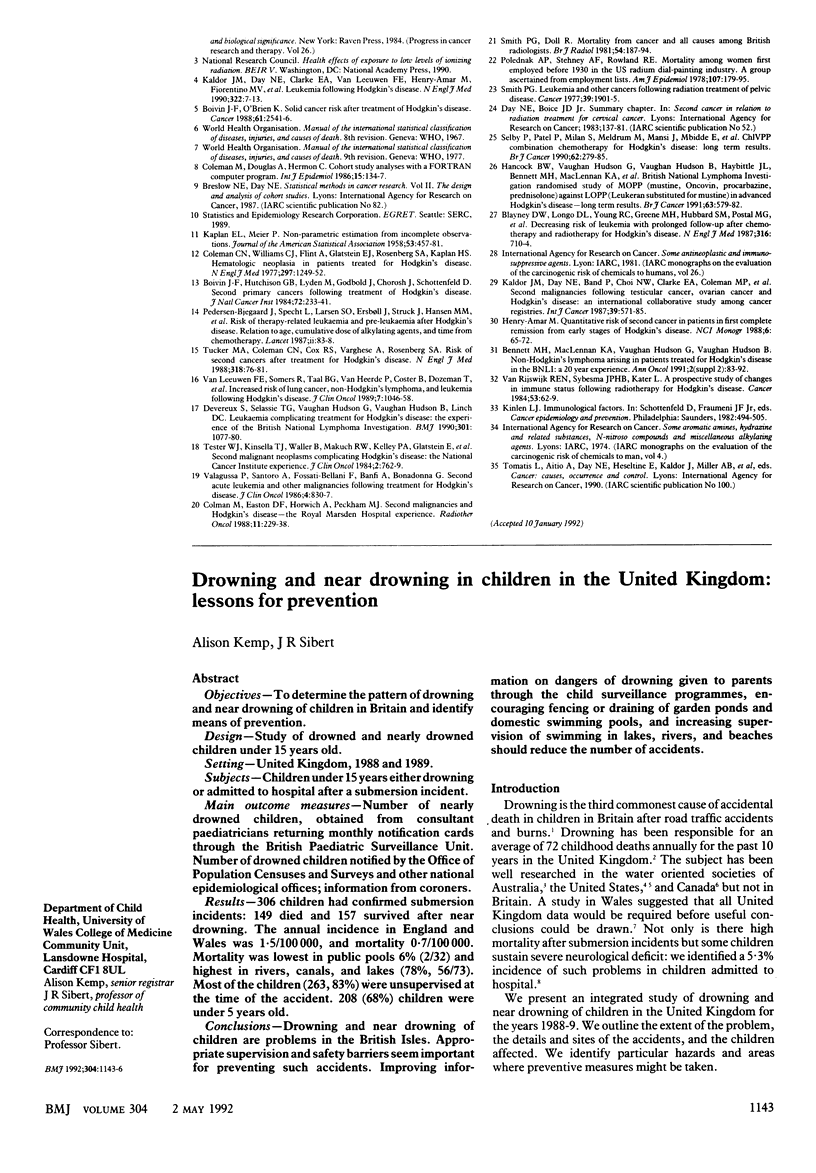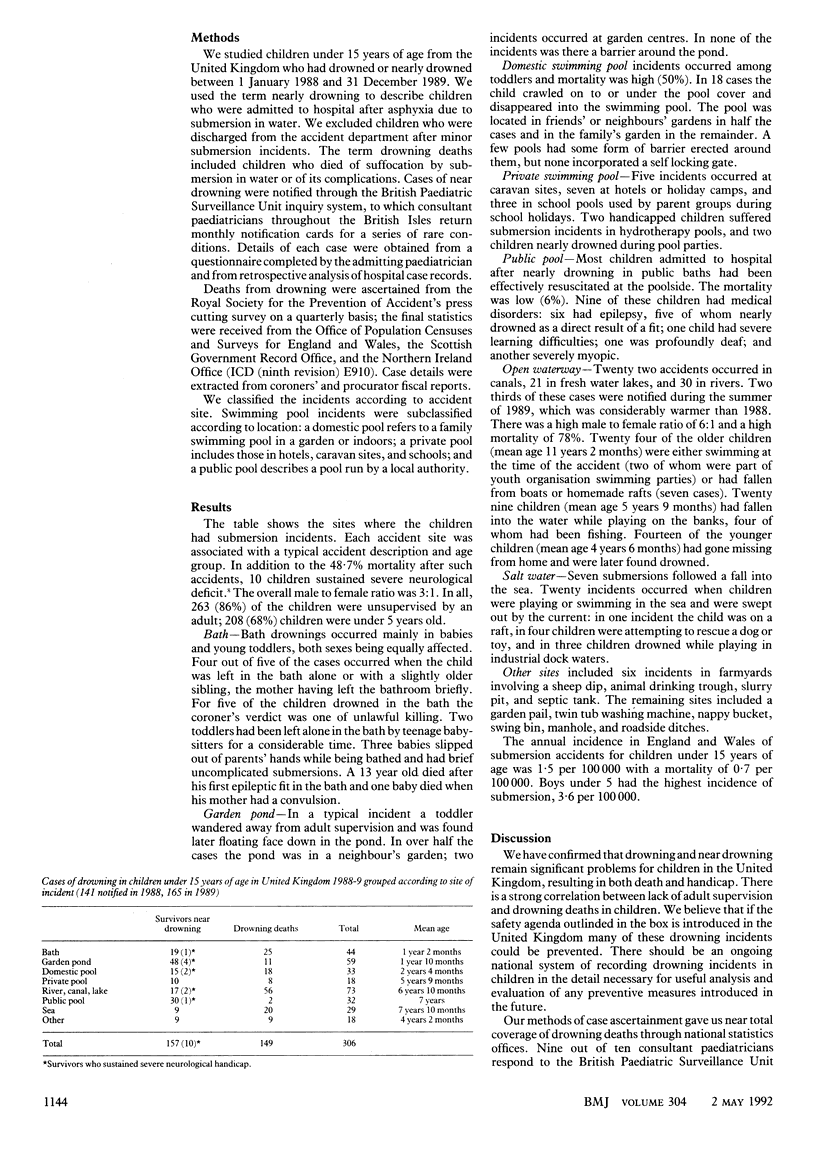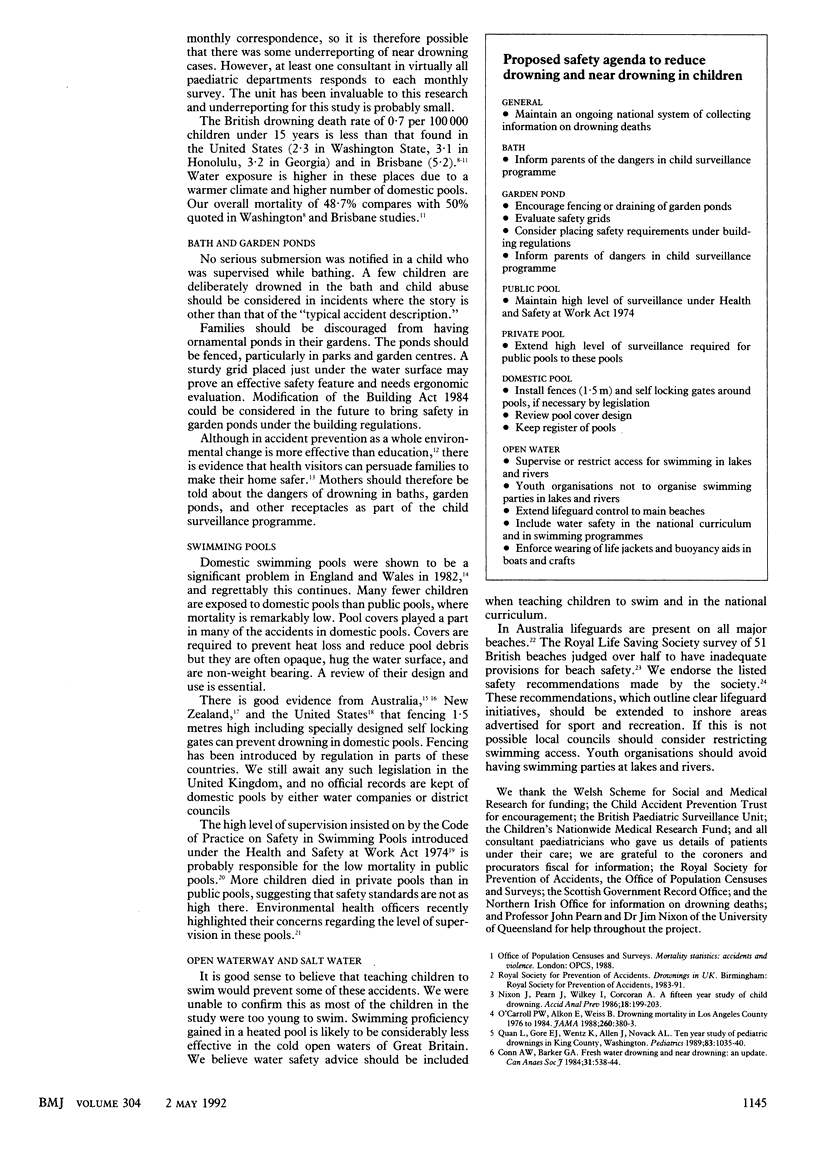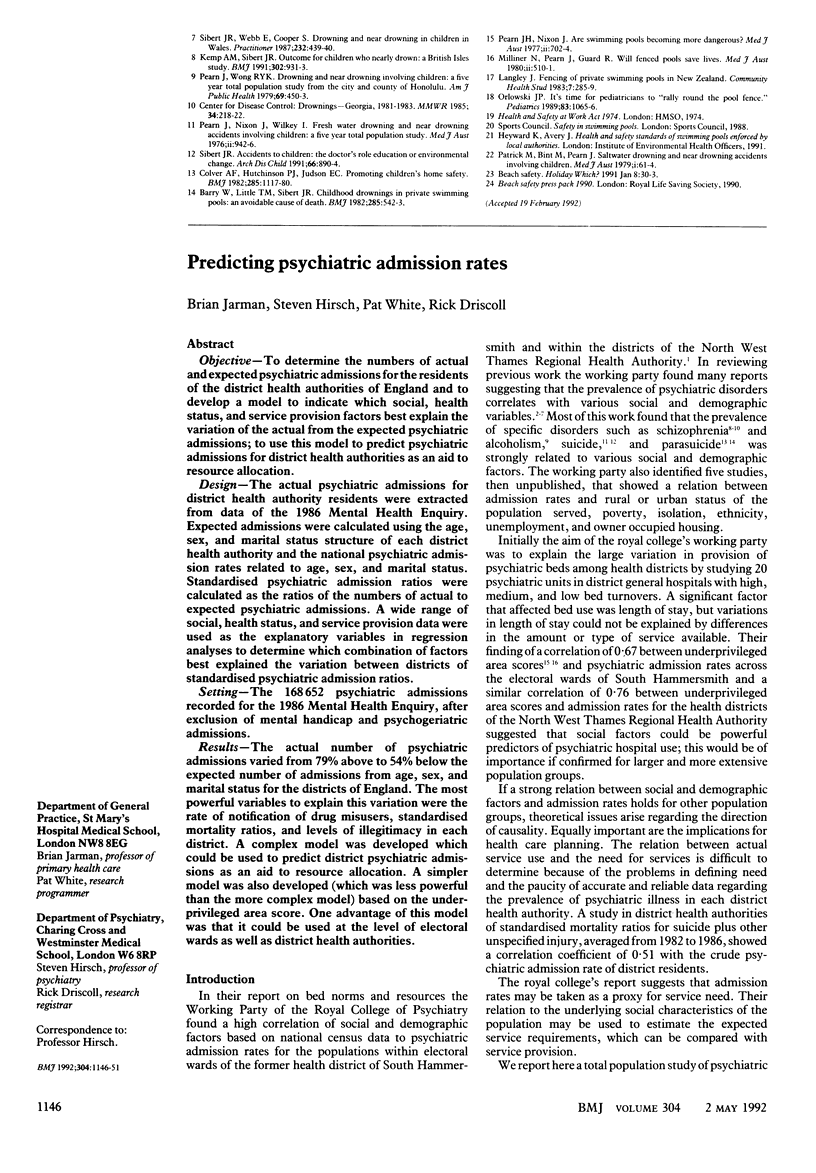Abstract
OBJECTIVES--To determine the pattern of drowning and near drowning of children in Britain and identify means of prevention. DESIGN--Study of drowned and nearly drowned children under 15 years old. SETTING--United Kingdom, 1988 and 1989. SUBJECTS--Children under 15 years either drowning or admitted to hospital after a submersion incident. MAIN OUTCOME MEASURES--Number of nearly drowned children, obtained from consultant paediatricians returning monthly notification cards through the British Paediatric Surveillance Unit. Number of drowned children notified by the Office of Population Censuses and Surveys and other national epidemiological offices; information from coroners. RESULTS--306 children had confirmed submersion incidents: 149 died and 157 survived after near drowning. The annual incidence in England and Wales was 1.5/100,000, and mortality 0.7/100,000. Mortality was lowest in public pools 6% (2/32) and highest in rivers, canals, and lakes (78%, 56/73). Most of the children (263, 83%) were unsupervised at the time of the accident. 208 (68%) children were under 5 years old. CONCLUSIONS--Drowning and near drowning of children are problems in the British Isles. Appropriate supervision and safety barriers seem important for preventing such accidents. Improving information on dangers of drowning given to parents through the child surveillance programmes, encouraging fencing or draining of garden ponds and domestic swimming pools, and increasing supervision of swimming in lakes, rivers, and beaches should reduce the number of accidents.
Full text
PDF



Selected References
These references are in PubMed. This may not be the complete list of references from this article.
- Barry W., Little T. M., Sibert J. R. Childhood drownings in private swimming pools: an avoidable cause of death. Br Med J (Clin Res Ed) 1982 Aug 21;285(6341):542–543. doi: 10.1136/bmj.285.6341.542. [DOI] [PMC free article] [PubMed] [Google Scholar]
- Braye S. G., Copplestone J. A., Gartell P. C. Neutropenic enterocolitis during mianserin-induced agranulocytosis. Br Med J (Clin Res Ed) 1982 Oct 16;285(6348):1117–1117. doi: 10.1136/bmj.285.6348.1117-a. [DOI] [PMC free article] [PubMed] [Google Scholar]
- Kemp A. M., Sibert J. R. Outcome in children who nearly drown: a British Isles study. BMJ. 1991 Apr 20;302(6782):931–933. doi: 10.1136/bmj.302.6782.931. [DOI] [PMC free article] [PubMed] [Google Scholar]
- Langley J. Fencing of private swimming pools in New Zealand. Community Health Stud. 1983 Oct;7(3):285–289. doi: 10.1111/j.1753-6405.1983.tb00060.x. [DOI] [PubMed] [Google Scholar]
- Milliner N., Pearn J., Guard R. Will fenced pools save lives? A 10-year study from Mulgrave Shire, Queensland. Med J Aust. 1980 Nov 1;2(9):510–511. doi: 10.5694/j.1326-5377.1980.tb100717.x. [DOI] [PubMed] [Google Scholar]
- Nixon J., Pearn J., Wilkey I., Corcoran A. Fifteen years of child drowning--a 1967-1981 analysis of all fatal cases from the Brisbane Drowning Study and an 11 year study of consecutive near-drowning cases. Accid Anal Prev. 1986 Jun;18(3):199–203. doi: 10.1016/0001-4575(86)90003-5. [DOI] [PubMed] [Google Scholar]
- O'Carroll P. W., Alkon E., Weiss B. Drowning mortality in Los Angeles County, 1976 to 1984. JAMA. 1988 Jul 15;260(3):380–383. [PubMed] [Google Scholar]
- Orlowski J. P. It's time for pediatricians to 'rally 'round the pool fence'. Pediatrics. 1989 Jun;83(6):1065–1066. [PubMed] [Google Scholar]
- Patrick M., Bint M., Pearn J. Saltwater drowning and near-drowning accidents involving children. A five-year total population study in south-east Queensland. Med J Aust. 1979 Jan 27;1(2):61–64. doi: 10.5694/j.1326-5377.1979.tb111997.x. [DOI] [PubMed] [Google Scholar]
- Pearn J. H., Wong R. Y., Brown J., 3rd, Ching Y. C., Bart R., Jr, Hammar S. Drowning and near-drowning involving children: a five-year total population study from the City and County of Honolulu. Am J Public Health. 1979 May;69(5):450–454. doi: 10.2105/ajph.69.5.450. [DOI] [PMC free article] [PubMed] [Google Scholar]
- Pearn J., Nixon J. Are swimming pools becoming more dangerous? Med J Aust. 1977 Nov 19;2(21):702–704. doi: 10.5694/j.1326-5377.1977.tb99227.x. [DOI] [PubMed] [Google Scholar]
- Pearn J., Nixon J., Wilkey I. Freshwater drowning and near-drowning accidents involving children: a five-year total population study. Med J Aust. 1976 Dec 18;2(25-26):942–946. doi: 10.5694/j.1326-5377.1976.tb115532.x. [DOI] [PubMed] [Google Scholar]
- Quan L., Gore E. J., Wentz K., Allen J., Novack A. H. Ten-year study of pediatric drownings and near-drownings in King County, Washington: lessons in injury prevention. Pediatrics. 1989 Jun;83(6):1035–1040. [PubMed] [Google Scholar]
- Sibert J. R. Accidents to children: the doctor's role. Education or environmental change? Arch Dis Child. 1991 Jul;66(7):890–893. doi: 10.1136/adc.66.7.890. [DOI] [PMC free article] [PubMed] [Google Scholar]
- Sibert J. R., Webb E., Cooper S. Drowning and near drowning in children. Practitioner. 1988 Apr 22;232(1447):439–440. [PubMed] [Google Scholar]


